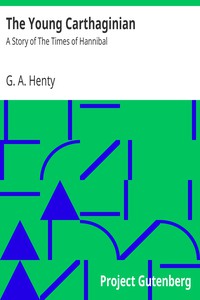The Young Carthaginian: A Story of The Times of Hannibal by G. A. Henty (no david read aloud .txt) 📕

Read free book «The Young Carthaginian: A Story of The Times of Hannibal by G. A. Henty (no david read aloud .txt) 📕» - read online or download for free at americanlibrarybooks.com
- Author: G. A. Henty
Read book online «The Young Carthaginian: A Story of The Times of Hannibal by G. A. Henty (no david read aloud .txt) 📕». Author - G. A. Henty
This was a great disappointment to him, as it would cause a long delay that it would be scarce possible to commence the march which he meditated that summer. As to advancing, with Saguntum in his rear, it was not to be thought of, for the Romans would be able to land their armies there and to cut him off from all communication with Carthagena and Carthage. There was, then, nothing to be done but to undertake the siege in regular order.
The army formed an encampment in a circle round the town. A strong force was left to prevent the garrison from making a sortie, and the whole of the troops were then marched away in detachments to the hills to fell and bring down the timber which would be required for the towers and walls, the bareness of the rock rendering it impossible to construct the approaches as usual with earth. In the first place, a wall, strengthened by numerous small towers, was erected round the whole circumference of the rock; then the approaches were begun on the western side, where attack was alone possible.
This was done by lines of wooden towers, connected one with another by walls of the same material; movable towers were constructed to be pushed forward against the great tower which formed the chief defence of the wall, and on each side the line of attack was carried onward by portable screens covered with thick hide. In the meantime the Saguntines were not idle. Showers of missiles of all descriptions were hurled upon the working parties, great rocks from the machines on the walls crashed through the wooden erections, and frequent and desperate sorties were made, in which the Carthaginians were almost always worsted. The nature of the ground, overlooked as it was by the lofty towers and walls, and swept by the missiles of the defenders, rendered it impossible for any considerable force to remain close at hand to render assistance to the workers, and the sudden attacks of the Saguntines several times drove them far down the hillside, and enabled the besieged, with axe and fire, to destroy much of the work which had been so labouriously carried out.
In one of these sorties Hannibal, who was continually at the front, overlooking the work, was seriously wounded by a javelin in the thigh. Until he was cured the siege languished, and was converted into a blockade, for it was his presence and influence alone which encouraged the men to continue their work under such extreme difficulties, involving the death of a large proportion of those engaged. Upon Hannibal's recovery the work was pressed forward with new vigour, and the screens and towers were pushed on almost to the foot of the walls. The battering rams were now brought up, and—shielded by massive screens, which protected those who worked them from the darts and stones thrown down by the enemy, and by lofty towers, from whose tops the Carthaginian archers engaged the Saguntines on the wall—began their work.
The construction of walls was in those days rude and primitive, and they had little of the solidity of such structures in succeeding ages. The stones were very roughly shaped, no mortar was used, and the displacement of one stone consequently involved that of several others. This being the case it was not long before the heavy battering rams of the Carthaginians produced an effect on the walls, and a large breach was speedily made. Three towers and the walls which connected them fell with a mighty crash, and the besiegers, believing that the place was won, advanced to the assault. But the Saguntines met them in the breach, and for hours a desperate battle raged there.
The Saguntines hurled down upon the assailants trunks of trees bristling with spearheads and spikes of iron, blazing darts and falariques—great blocks of wood with projecting spikes, and covered thickly with a mass of pitch and sulphur which set on fire all they touched. Other species of falariques were in the form of spindles, the shaft wrapped round with flax dipped in pitch. Hannibal fought at the head of his troops with desperate bravery, and had a narrow escape of being crushed by an enormous rock which fell at his feet; but in spite of his efforts and those of his troops they were unable to carry the breach, and at nightfall fell back to their camp, having suffered very heavy losses.
Singularly enough the French columns were repulsed in an effort to carry a breach at almost the same spot, the Spaniards hurling among them stones, hand grenades of glass bottles and shells, and defending the breach with their long pikes against all the efforts of Suchet's troops.
Some days passed before the attack was renewed, as the troops were worn out by their labours. A strong guard in the meantime held the advanced works against any sorties of the Saguntines.
These, on their side, worked night and day, and by the time the Carthaginians again advanced the wall was rebuilt and the breach closed. But Hannibal had also been busy. Seeing that it was impossible for his troops to win an entrance by a breach, as long as the Saguntines occupied every point commanding it, he caused a vast tower to be built, sufficiently lofty to overlook every point of the defences, arming each of its stages with catapults and ballistas. He also built near the walls a great terrace of wood higher than the walls themselves, and from this and from the tower he poured such torrents of missiles into the town that the defenders could no longer remain upon the walls. Five hundred Arab miners now advanced, and these, setting to work with their implements, soon loosened the lower stones of the wall, and this again fell with a mighty crash and a breach was opened.
The Carthaginians at once swarmed in and took possession of the wall; but while the besiegers had been constructing their castle and terrace, the Saguntines had built an interior wall, and Hannibal saw himself confronted with a fresh line of defences.
As preparations were being made for the attack of the new defences messengers arrived saying that the Carpatans and Orotans, furious at the heavy levies of men which had been demanded from them for the army, had revolted. Leaving Maharbal to conduct the siege in his absence, Hannibal hurried away with a portion of his force, and returned in two months, having put down the revolt and severely punished the tribesmen.
While the siege





Comments (0)